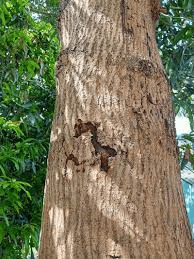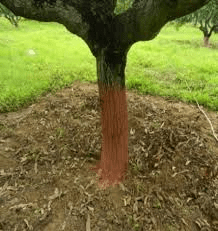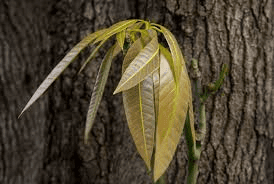Mango stems, like other parts of the mango tree, have various uses and hold significant economic, agricultural, and medicinal importance. Although often discarded, mango stems are a valuable resource with a range of applications that contribute to the sustainability and profitability of mango cultivation.
Agriculturally, mango stems play a crucial role in the growth and health of the mango tree. Pruning mango trees, which involves cutting back the stems, is a common practice to manage tree size, improve air circulation, and enhance fruit production. The pruned stems can be used as organic mulch, which helps retain soil moisture, suppress weed growth, and add organic matter to the soil as they decompose. This practice supports sustainable farming by reducing the need for synthetic mulches and fertilizers.
Mango stems can also be processed into biochar, a form of charcoal used to improve soil health. Biochar enhances soil fertility, increases water retention, and sequesters carbon, thereby contributing to climate change mitigation. The production of biochar from mango stems provides a way to utilize agricultural waste and promotes sustainable land management practices.
In the field of medicine, mango stems have shown potential due to their rich content of bioactive compounds. Studies have indicated that extracts from mango stems possess antimicrobial, antioxidant, and anti-inflammatory properties. These extracts can be used in the development of herbal medicines and nutraceutical products aimed at treating various health conditions. For instance, the polyphenols and flavonoids found in mango stems may help in managing diabetes, reducing inflammation, and combating infections.
Mango stems are also used in traditional medicine. In some cultures, the bark and sap from mango stems are used to treat ailments such as diarrhea, dysentery, and respiratory issues. The stems are sometimes boiled to make decoctions, which are consumed to alleviate symptoms of these conditions. Additionally, the sap from mango stems is applied topically to treat wounds and skin infections, leveraging its antimicrobial properties.
From an economic perspective, the utilization of mango stems adds value to the mango industry by creating additional revenue streams. By converting agricultural waste into valuable products such as biochar, herbal medicines, and organic mulches, farmers and producers can increase their income and contribute to a circular economy. This approach also supports environmental sustainability by minimizing waste and promoting the use of natural resources.
In the field of crafts and construction, mango stems can be used as a source of natural material. The wood from mango stems is often used to make small household items, furniture, and handicrafts. The durability and aesthetic appeal of mango wood make it a popular choice for these applications. Using mango stems in this way provides an eco-friendly alternative to more commonly used woods and supports sustainable forestry practices.
Mango stems are a valuable by-product of mango cultivation with numerous applications in agriculture, medicine, and industry. Their use in sustainable farming practices, medicinal products, and crafts highlights their economic and environmental significance.
As research and technology continue to advance, the potential uses of mango stems are likely to expand, further enhancing their value and contribution to a sustainable future. By recognizing and utilizing the full potential of mango stems, the mango industry can achieve greater sustainability and profitability.
The Economic Importance and Uses of Mango Stems

1. Herbal Medicine: Mango stems are used in traditional medicine for their therapeutic properties. They are believed to help with digestive issues, fever, and infections.
2. Animal Feed: The stems are processed and used as animal feed, providing roughage and nutrients to livestock.
3. Composting: Mango stems can be composted to produce organic fertilizer, enhancing soil fertility.
4. Biofuel Production: Mango stems can be converted into biofuels, providing a renewable energy source.
5. Handicrafts: Artisans use mango stems to create eco-friendly crafts and decorative items.
6. Construction Material: Mango stems can be processed into construction materials such as fiberboard and particleboard.
7. Pulp for Paper: Mango stems are pulped to produce paper and cardboard, contributing to the paper industry.
8. Natural Pesticides: Extracts from mango stems are used as natural pesticides in organic farming.
9. Furniture Making: Mango stems can be used to make small furniture pieces and home decor items.
10. Aromatherapy: Essential oils from mango stems are used in aromatherapy for their calming effects.
11. Charcoal Production: Mango stems can be carbonized to produce charcoal for cooking and heating.
12. Dye Production: Mango stems can be used to produce natural dyes for textiles and crafts.
13. Mulch: Shredded mango stems are used as mulch in gardens to retain soil moisture and suppress weeds.
14. Water Purification: Mango stems are used in traditional methods to purify water.
15. Biochar: Mango stems can be converted into biochar, which is used to improve soil health and sequester carbon.
16. Erosion Control: Mango stems are used in erosion control products to stabilize soil and prevent erosion.
17. Packaging Material: Processed mango stems are used to create eco-friendly packaging materials.
18. Essential Oils: Extracted oils from mango stems are used in various cosmetic and therapeutic products.
Read Also: 3 Health Benefits of Slippery Elm (Ulmus fulva
Products and By-products That Can Be Derived From Mango Stems

1. Herbal Supplements: Mango stems are processed into supplements that are used for their health benefits.
2. Animal Feed: Processed mango stems are used as roughage in livestock feed.
3. Organic Fertilizer: Compost made from mango stems is used to enrich soil.
4. Bioethanol: Mango stems can be fermented to produce bioethanol, a renewable fuel source.
5. Handicrafts: Mango stems are used to create eco-friendly crafts and decor items.
6. Fiberboard: Processed mango stems are used to make fiberboard for construction and furniture.
7. Pulp for Paper: Mango stems are pulped and used to produce paper and cardboard.
8. Natural Pesticides: Extracts from mango stems are used to formulate natural pesticides.
9. Furniture: Small furniture pieces and home decor items are crafted from mango stems.
10. Aromatherapy Oils: Essential oils from mango stems are used in aromatherapy and skincare products.
11. Charcoal: Mango stems are carbonized to produce charcoal for cooking and heating.
12. Natural Dyes: Mango stems are used to produce dyes for textiles and crafts.
13. Mulch: Shredded mango stems are used as mulch in gardens.
14. Water Filters: Mango stems are used in traditional water purification methods.
15. Biochar: Processed mango stems are converted into biochar for agricultural use.
16. Erosion Control Products: Mango stems are used in products designed to prevent soil erosion.
17. Eco-friendly Packaging: Processed mango stems are used to create sustainable packaging materials.
18. Essential Oils: Extracted oils from mango stems are used in various cosmetic and therapeutic products.
Read Also: 6 Health Benefits of Oregano (Origanum vulgare)
Frequently Asked Questions (FAQ’s) About Mango Stems

1. What are the uses of mango stems?
Mango stems are used in various industries, including herbal medicine, animal feed, composting, biofuel production, and more.
2. How are mango stems used in traditional medicine?
Mango stems are used in traditional medicine to treat digestive issues, fever, and infections.
3. Can mango stems be used as animal feed?
Yes, mango stems can be processed into animal feed, providing roughage and essential nutrients for livestock.
4. How are mango stems used in biofuel production?
Mango stems can be converted into bioethanol and biochar, which are used as renewable energy sources.
5. Are mango stems used in making paper?
Yes, mango stems are pulped and used to produce paper and cardboard.
6. How do mango stems benefit soil health?
Mango stems can be composted to create organic fertilizer, improving soil fertility and structure.
7. Can mango stems be used in construction?
Yes, mango stems can be processed into fiberboard and particleboard for construction and furniture making.
8. How are mango stems used in aromatherapy?
Essential oils extracted from mango stems are used in aromatherapy for their calming and therapeutic effects.
9. What role do mango stems play in erosion control?
Mango stems are used in erosion control products to stabilize soil and prevent erosion.
10. How are mango stems used in natural pesticides?
Extracts from mango stems are formulated into natural pesticides for use in organic farming.
Read Also: Practical Steps to Covert Paper Wastes into New Paper Products

